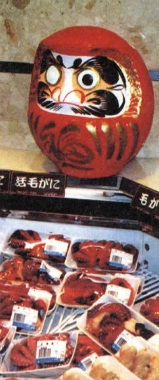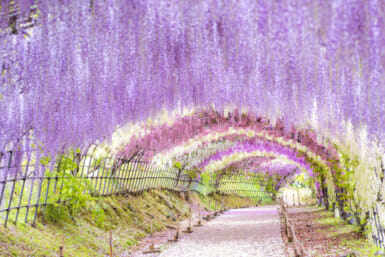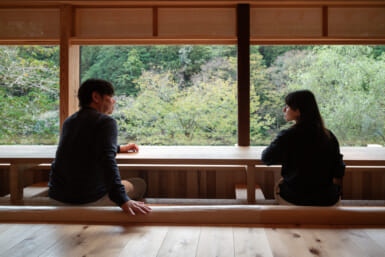by Denny Sairgent
photos by Rebecca Sargent
We are well into 1993 and it’s time to get a new Daruma doll.
If you’ve never seen one, you won’t have to look far, especially at this time of the year. Many businessmen prominently display these red, bearded little balllike figures, as do a variety of folks ranging from politicians to housewives. Keep an eye out and you’ll see new ones popping up all over the city as the new year progresses.
What are all these little armless dolls for? Making dreams come true, or so the story goes.
When somebody has a wish (to make a lot of money, for example), he or she buys a Daruma and paints in the left eye. This is usually done some time near the beginning of the year. If the wish comes true, the other eye is painted in.
Then, usually at the end of the year, the Daruma dolls are brought to a temple or shrine (where they will be burned) and offered with prayers of thanks. A new Daruma is bought and the cycle begins all over again.
This tradition started at the Daruma Temple on Mt. Shorin in Takasaki City, Gumma Prefecture. Legend has it the ninth chief priest, Togoku Osho, urged the inhabitants to make images of Daruma so they could sell them and make money to survive. It seems a terrible famine had hit the region and the priest, despairing for the lives of his people, was inspired by this novel form of free enterprise.
Daruma were then sold there every January and this eventually became known as the Daruma Ichi or Daruma fair, a custom that quickly spread throughout Japan. Nowadays almost every temple and shrine in Japan sports booths selling Daruma during the first part of every new year.
Traditional Daruma dolls are pale-faced with red bodies. On the front of the belly is painted the characters for “success in business, “safe family” or even “win the election!” Often the huge, exaggerated eyebrows look like cranes, a very old symbol of longevity and luck, and the whiskers resemble tortoises, ancient symbols of money and wealth.
“Daruma” probably comes from the word “dharma” which means the embodied spirit or “law” of Buddhist teachings carried into China by an Indian Buddhist priest popularly known as Bodhidharma.
The often-painted image of this priest is, in fact, the model upon which the Daruma doll is based. Bodhidharma founded the sect of Zen (Chan) after meditating for nine years. Legend has it he spent so much time sitting still and meditating that his arms and legs withered always and thus he assumed the shape of the traditional Daruma doll.
In this way he also became the ultimate symbol of single-minded devotion towards attaining a goal. Bodhidharma died in 536 A.D.,but the sect he founded made its way through China and eventually established itself in Japan. Along with Zen Buddhism came the image and legend of its founder, and so the Daruma doll was born.
When you buy a Daruma doll, it “sits and meditates” for you on the desire you wish to obtain. This frees you to go on with your life, knowing that Daruma is working his magic for you every time you see him sitting there with his one open eye! He is also a constant reminder that you have yet to achieve your goal and had better get busy and work harder.
This tradition of using dolls in rituals to obtain something is very old and actually traces back to Shinto practices. When Buddhism was absorbed by Japanese culture, Bodhidharma thus became a kind of “lucky god” whose image was said to have magical properties. Though these dolls aren’t taken quite so seriously today, a number of people still believe in their power.
The cone-shaped Daruma dolls, called Sankaku Daruma, from neighboring Niigata Prefecture, deserve a special mention. These are also bought at the beginning of the year and are kept on the household kami-dana or Shinto altar, to protect the family. We can see from these special Daruma dolls how reverently they were probably treated in the past.
Many Daruma dolls are still made in the Takasaki area, though the practice of making Daruma of all shapes, sizes, colors and forms has spread all over Japan. They range from microscopic to gigantic and are usually made of hariko or papier-mache painted with enamel paints.
The red body supposedly represents the dhoti or ancient orange-red robe of a wandering Indian holy man. In some places Daruma are still handmade, but today most Daruma dolls are mass-produced, though much of the detail work and the beautiful script calligraphy is still done by hand.
Most Daruma dolls are weighted at the bottom so they keep bobbing back up, no matter what you do to them. This certainly makes them a good symbol for modern Japan. The popular adage Nana-korobi-yaoki or “Seven times pushed down, eight times rise up,” is the Japanese equivalent of “If at first you don’t succeed, try, try again,” and was inspired by this doll.
Do Daruma dolls really work? Will they help you attain your wish? Many people swear they do. The only way to really find out is to buy one yourself, paint in the left eye and make a wish. If your wish comes true, don’t forget to paint in the other eye, or your success might not last. No matter what happens, you can always get a new one next year—and try, try again.
Daruma alert
One of the most famous Daruma Ichi in Japan will be held in the Tokyo area on Mar. 3-4 at Jindaiji Temple. To get there, take the Keio Line to Chofu and change to the Jindaiji-bound bus. The trip is less than one hour from Tokyo. Jindaiji is beautiful and this massive Daruma festival is not to be missed.











